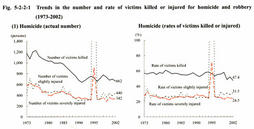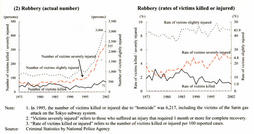| Previous Next Index Image Index Year Selection | |
|
|
1 Number and rate of victims killed or injured Not only homicide, which is committed with the primary intention of killing people, but also robbery, which is not committed with such intention, is also very likely to harm victims' lives or bodies. For this reason, the number of victims killed or injured by these offenses and the rate of such victims per reported case would be useful indicators to judge whether these types of offenses themselves are of a violent nature that is likely to kill or injure people. More specifically, in order to identify the trends of maliciousness in these heinous offenses, it is necessary to examine the number of victims killed or injured as well as the rates of victims killed, victims severely injured (suffering an injury that requires 1 month or more for complete recovery), and victims slightly injured per reported case. As an overwhelming majority of the injured are slightly injured, they are divided into those severely injured and those slightly injured to avoid misleading conclusions. Fig. 5-2-2-1 shows the trends in the number of victims and the rates of victims killed, victims severely injured, and victims slightly injured in homicide and robbery cases.
As for homicide, the outstanding rise in the number of victims injured in 1995 was due to a larger number of victims injured by the Sarin gas attack on the Tokyo subway system by Aum Shinrikyo cult members. Except for this, the numbers of victims killed, victims severely injured, and victims slightly injured were on the decline until 1991 and they have been leveling off or rising slightly subsequently. The rates of victims killed, victims severely injured, and victims slightly injured have also remained flat without much fluctuation. As for robbery, on the other hand, due to the fact that the number of reported cases of robbery resulting in bodily injury took an upward turn in 1991 and it has been showing a remarkable rise since 1996 and that the number of reported cases of robbery resulting in death also turned up in 1996, the numbers of victims injured and victims killed started to increase in these years respectively. In particular, the number of victims severely injured increased 3.5-fold, from 94 in 1995 to 335 in 2002. The rate of victims severely injured has been on the rise, causing a concern that robbery offenses are becoming more malicious. Fig. 5-2-2-1 Trends in the number and rate of victims killed or injured for homicide and robbery (1973-2002) |

